
Increase the output current of the very low dropout voltage regulator and realize the parallel design of uniform heat dissipation
Introduction
Each new generation of computing system always requires higher total power and lower power supply voltage than the previous generation products, so that power supply designers face the problem of maintaining higher output current in a smaller area. Under conditions of high power density and low output voltage, heat dissipation becomes the primary design consideration, especially for linear regulators in low-noise applications. Parallel LDO regulators can increase supply current and reduce heat dissipation, thereby reducing the temperature rise of any specific component and the size and number of heat sink components required.
This article explains how to connect a 3 A LT3033 very low dropout voltage regulator (VLDO) in parallel to generate more than 3 A current and improve heat dissipation. Utilizing the built-in output current monitoring function of LT3033 can simplify the design of parallel circuit and realize current sharing.
The input voltage range of the LT3033 is 1.14 V to 10 V, the output voltage can be as low as 0.2 V, and the load current can reach 3 A. The pressure difference at full load is only 95 mV. The quiescent current is 1.8 mA during operation and drops to 22 μA during shutdown. The current limiting function and thermal protection that can be set by the user make it robust for high current and low voltage applications.
Reference design: 3 A, single VLDO application
Figure 1 shows that the LT3033 provides a 0.9V, 3A output through a 1.2V input power supply. The IN and OUT pins require very low ESR ceramic capacitors of at least 10 μF to maintain stability. Adding a feedforward capacitor (CFF) between the VOUT and ADJ pins can improve transient response and reduce output voltage noise. Setting a 10 nF bypass capacitor between the REF/BYP pin and GND can usually reduce the output voltage noise to 60 μV rms in a bandwidth of 10 Hz to 100 kHz and soft-start the reference voltage source. The minimum input voltage required for regulation is equal to the regulation output voltage VOUT plus the differential pressure or 1.14 V, whichever is greater. The demo board is shown in Figure 2.
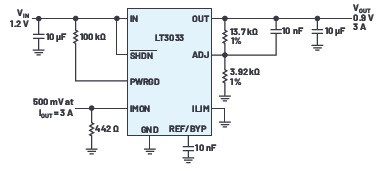
Figure 1. Typical application of LT3033.
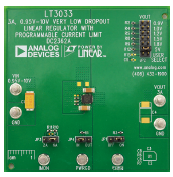
Figure 2. LT3033 demo board.
Customers can set the current limit by connecting a resistor between the ILIM pin and GND, and the accuracy can reach ±12% in a wide temperature range. When the differential voltage between input and output exceeds 5 V, the internal current limit with foldback function will replace the external current limit.
The LT3033 realizes output current monitoring by measuring the resistance voltage from IMON to GND. The IMON pin is the collector of the PNP inside the chip. It mirrors the current of the LT3033 output PNP at a ratio of 1:2650. When the resistor voltage is not higher than VOUT–400 mV, it is proportional to the output current.

The output current monitoring function helps to realize the current sharing of multiple LT3033s.
Despite the small size of the LT3033, it still integrates many protection functions, including internal current limit with foldback function, thermal limit, reverse current and battery reverse connection protection.
Two LT3033s in parallel for 6 A applications
For applications requiring more than 3 A current, you can use its current monitoring function to connect multiple LT3033s in parallel. Figure 3 shows two LT3033 and two 2N3904 NPN devices in parallel to produce 1.5 V, 6 A output. The IN pin and OUT pin of each device are connected separately. An LT3033 acts as the master device, controlling another LT3033 slave device.
Combine the IMON pin with the NPN current mirror to create a simple amplifier. The amplifier injects current into the feedback voltage divider of the LT3033 slave device, forcing the IMON current of each LT3033 to be equal. The 100 Ω resistor can provide 113 mV emitter negative feedback under full load conditions to ensure good current mirror matching. The output voltage of the LT3033 slave device is set to 1.35 V, which is 10% lower than the circuit output to ensure that the LT3033 master device has the control right. The feedback resistance of the LT3033 slave device is split into multiple sections to ensure that sufficient margin is provided for the NPN of the slave device. A combination of a 10 nF capacitor and 5.1 kΩ resistor is added to the IMON pin of the slave device to compensate the frequency of the feedback loop.
Although the circuit can provide 6 A load current, the mismatch between the two NPN devices causes uneven heat distribution on the circuit board, which limits the current sharing accuracy. Using matched single-chip transistors (for example, Analog Devices’ MAT14) instead of two discrete NPN devices, higher current sharing accuracy can be obtained. MAT14 is a four-channel single-chip NPN transistor with excellent parameter matching performance. Its maximum current gain matching is 4%.
Figure 4 compares the corresponding output current of each LDO regulator when using discrete and matched NPN devices. Compared with 2N3904, the current mismatch rate of MAT14 current mirror has dropped from 5.3% to 1.6%.
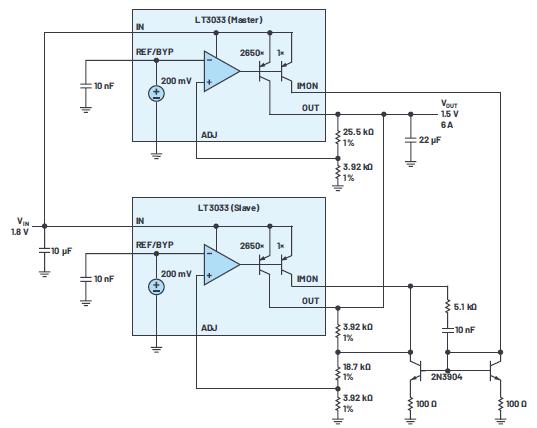
Figure 3. Two LT3033s are connected in parallel.
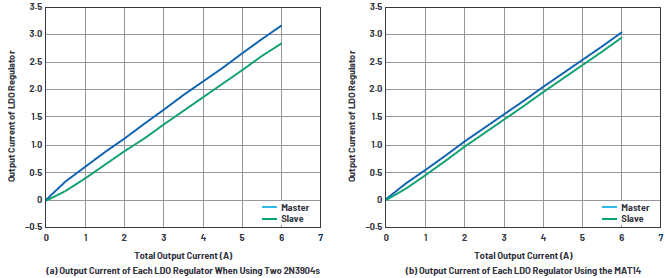
Figure 4. By using matched MAT14 single-chip quad-channel transistors and parallel LDO regulators, the loss distribution is reduced.
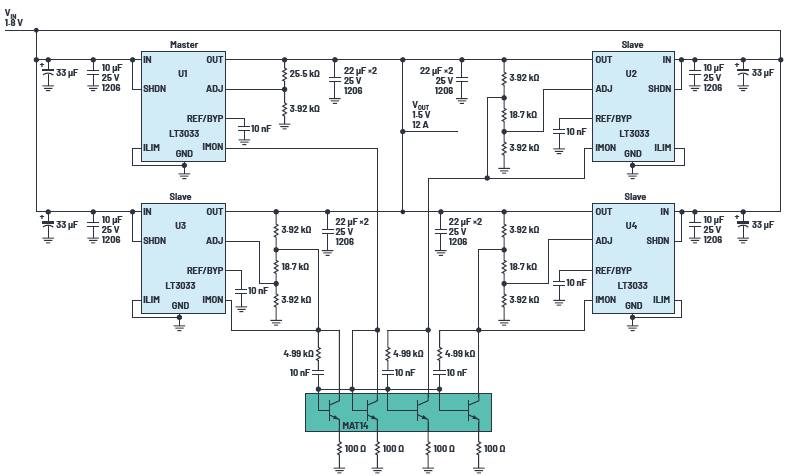
Figure 5. Using MAT14, four LT3033 are connected in parallel.

Figure 6. Thermal performance of four LT3033s in parallel.
Use matching components to connect four LT3033s in parallel to achieve balanced current sharing and uniform heat dissipation
By expanding the current mirror and adding LT3033 slave devices, the parallel circuit architecture can be expanded as needed to use more LT3033. Figure 5 shows a current sharing solution using MAT14 and four LT3033 in parallel. The thermal performance is shown in Figure 6. The temperature of the four LT3033 ranges from 51°C to 58°C. Considering the voltage drop of each device along the input trace, the heat dissipation on the circuit board is even, indicating that the solution achieves a balanced current sharing. Figure 7 shows the transient response of a 12 A power supply operating at a 1.8 V input and providing a 1.5 V output.
Figure 7. Load transient response of four LT3033s connected in parallel.
in conclusion
The LT3033 is a 3A VLDO regulator in a 3 mm × 4 mm package. Its built-in output current monitoring function can be used for high current applications by connecting multiple LT3033 VLDO regulators in parallel. The typical differential pressure of the LT3033 under full load conditions is only 95 mV, which is very suitable for high current applications from low input voltage to low output voltage, and is equivalent to the electrical efficiency of a switching regulator. Other features include settable current limit, power good sign and thermal limit, which can provide a reliable and stable solution. Battery-powered systems can benefit from low quiescent current and reverse battery protection.
The Links: LSWBL6361A LQ057Q3DG01


